- Home
- Knowledge Base
- Getting Started
- For new treasurers with an existing account
- QuickStart Guide for new treasurers with an existing MoneyMinder account
QuickStart Guide for new treasurers with an existing MoneyMinder account
Table of Contents
- Add a new financial year
- Copy your bank accounts from the prior year
- Set up your budget
- Enter Transactions & Attach Receipts
- View Some Reports
- Add Users
- Set Up Your Own Custom Store
- Upload Documents
1. Add a new financial year
Add a new financial year by clicking the Financial Year dropdown in the upper left and selecting Add new financial year.
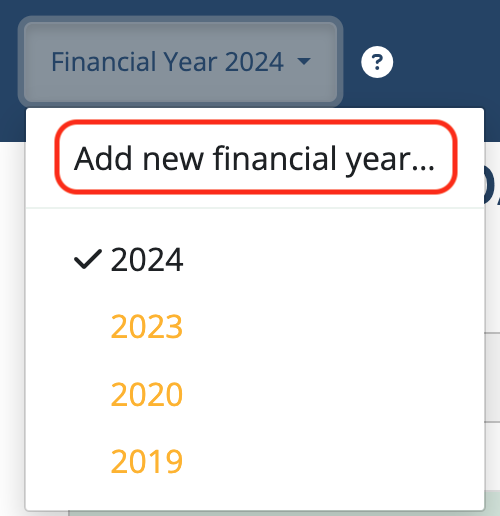
Identify the year you’d like to add and click Create.
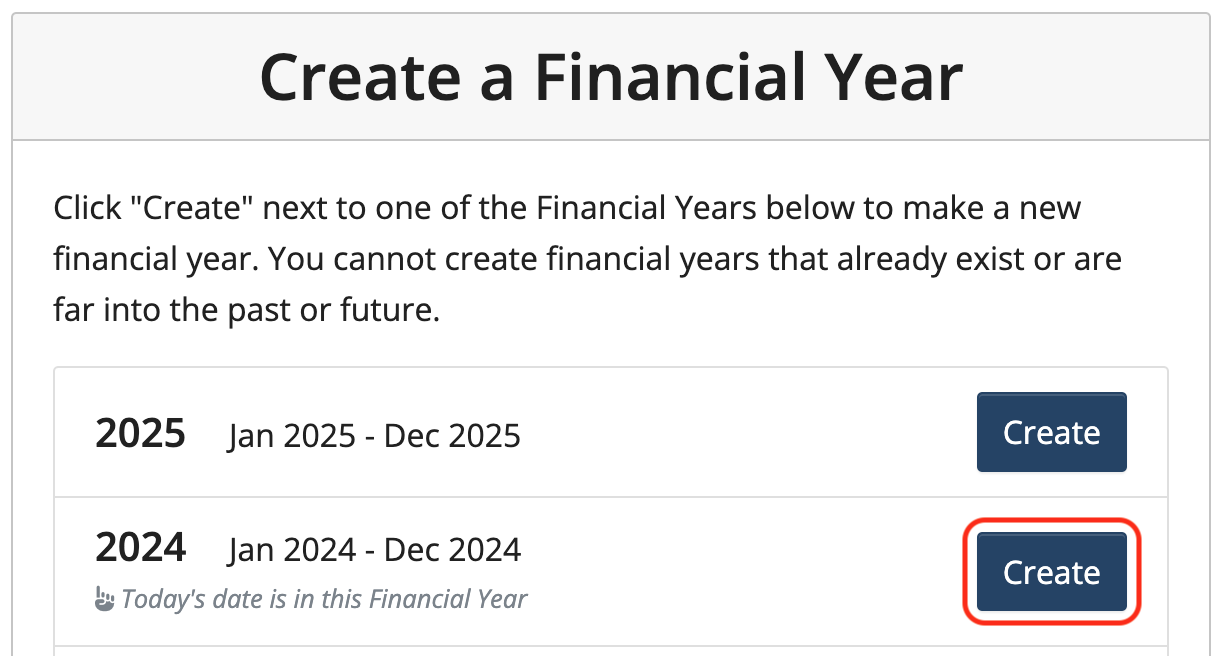
The financial year will appear at the top of the screen under the group name with the range that financial year covers.
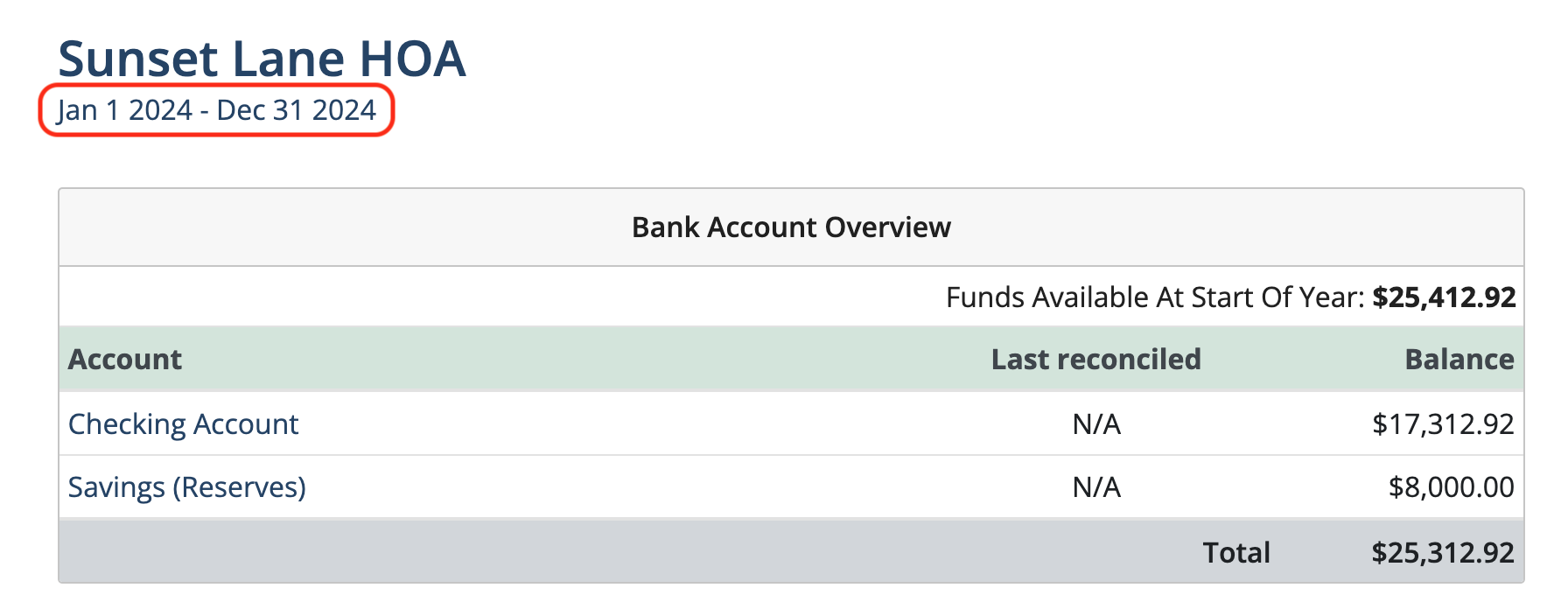
2. Copy bank accounts from the prior year
Click Banking in the sidebar.
![]()
Select all or select only certain bank accounts to be copied.

Click Copy Bank Accounts when selections have been made.

To carry forward bank balances and uncleared transactions, click Bank Account Details to the right of the bank account.

Note: If there is a checkmark next to Bank Account Details, that means the account is reconciled through the end of the last financial year and banking can be carried forward into the new financial year.
Click Carry Forward Last Year’s Account Information.

NOTE: This will replace the current balance and uncleared transactions with those copied from the prior year.
Click Save.
Set up new bank accounts:
Click Banking in the sidebar.
![]()
Click the Add Account dropdown.

Choose which type of account to add from the dropdown list.
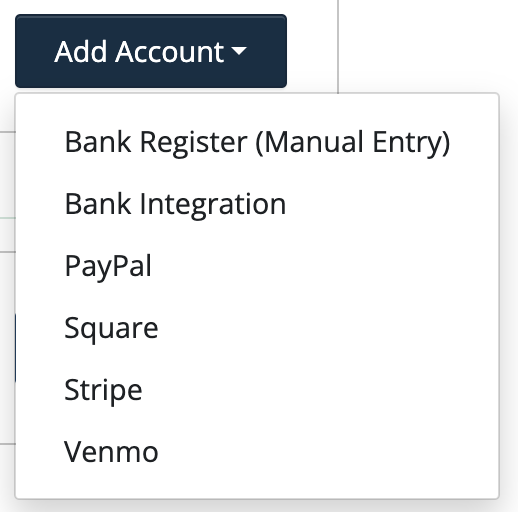
Enter the bank account name and starting balance at the beginning of the financial year. This should be taken directly from the bank statement.

Click Add Uncleared Deposit or Add Uncleared Withdrawal to enter outstanding deposits or withdrawals from the prior financial year that did not clear the bank by the start of the new financial year.

Note that entries made in this section do not affect current year numbers. They are placeholders for reconciliations in the new financial year. It is most transparent to enter the bank statement opening balance, which is easily verifiable, and then enter any known outstanding items to arrive at a true starting balance for the year.
For uncleared deposits: Enter the date, reference information, details, and the amount. Continue to do this for every deposit in your previous year that did not clear the bank by the end of the financial year.

For uncleared withdrawals: Enter the date, check number or reference information, who it was paid to, and the amount.

When finished adding uncleared transactions, click Save.
3. Set up a budget in the new financial year
Click Budget in the sidebar.
![]()
A budget can be created by using one of the following:
- Copy a budget from another financial year.
- Select one of MoneyMinder’s templates.
- Add a budget from scratch.
Note: Once the Budget is saved, you will not be able to start over.
When entering a budget, keep in mind that Headings and Subheadings are a way to organize the budget and Categories are the detailed area of activity that you want to track.

Copy an existing budget:
Select a year from the dropdown under Copy a budget that you set up in a previous financial year. Choose one of the years displayed below.
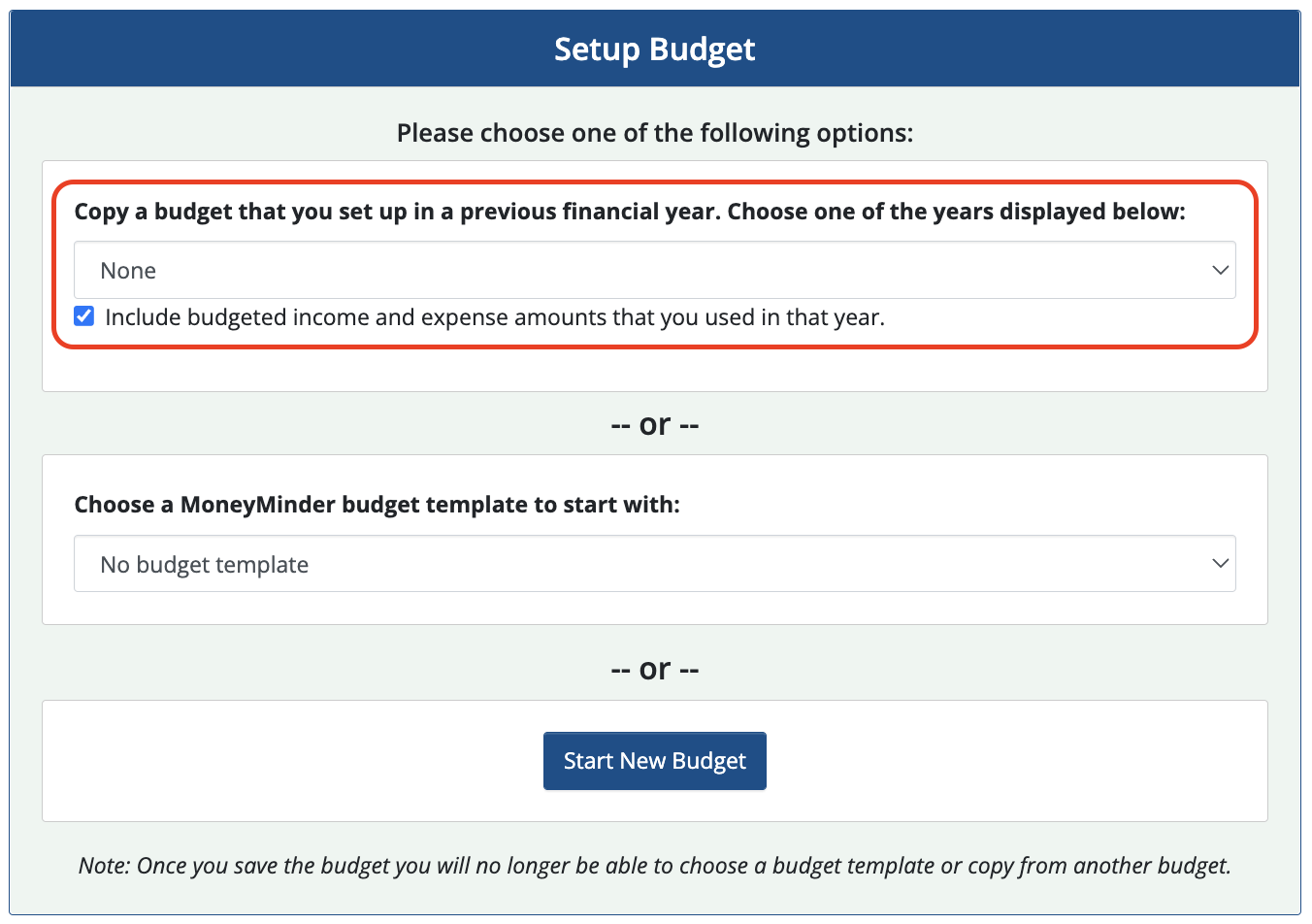
This will copy a budget from another financial year into the current year. The copied budget can be modified to reflect any changes.
When finished, click Save Changes at the top of the budget.
Select a budget template:
Select a budget template from the dropdown under Choose a MoneyMinder budget template to start with.
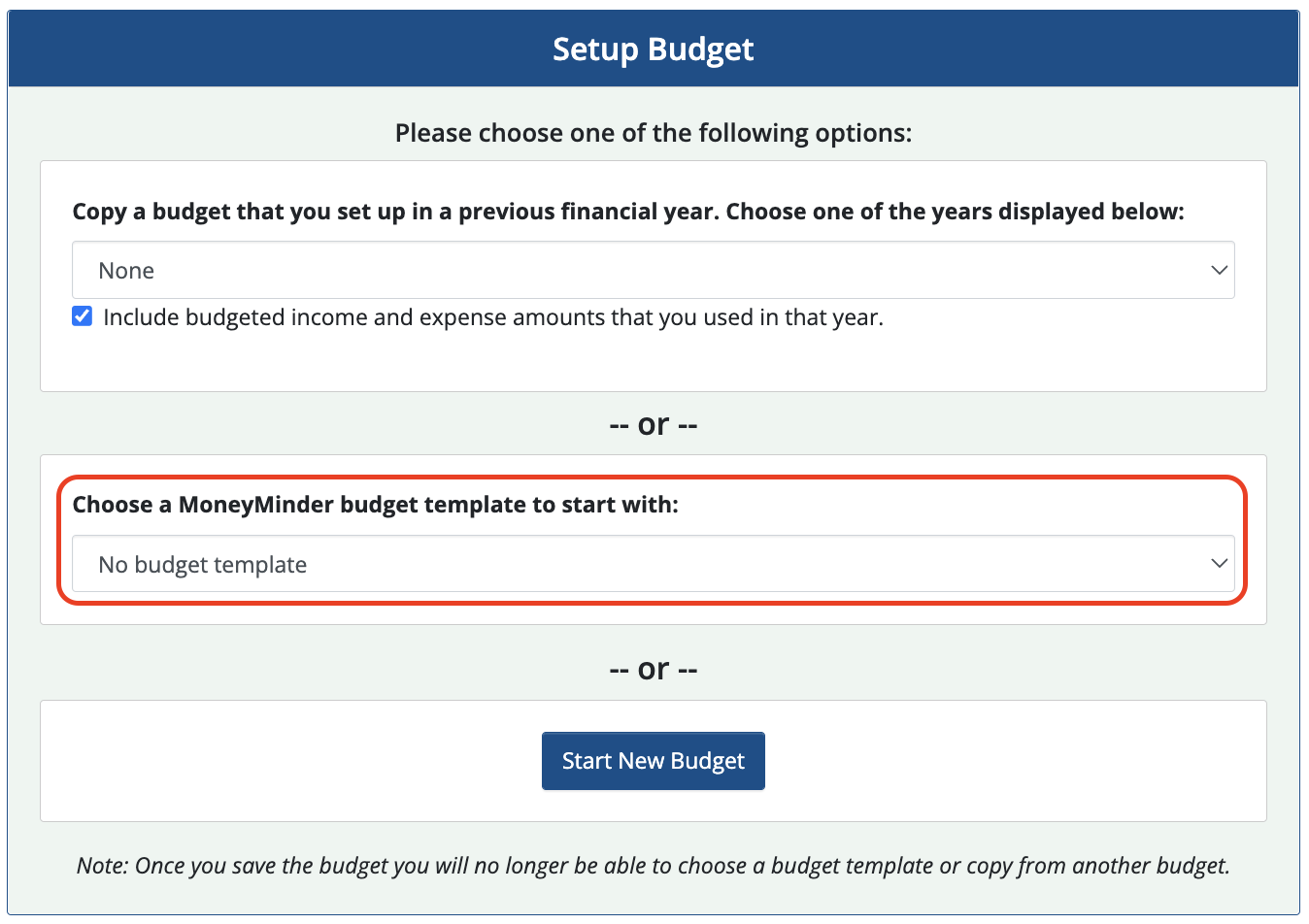
A sample budget will auto-populate. Changes can be made to modify the budget to suit your group’s activities.
When finished, click Save Changes at the top of the budget.
Add a budget from scratch:
Click Start New Budget to begin creating a new budget.
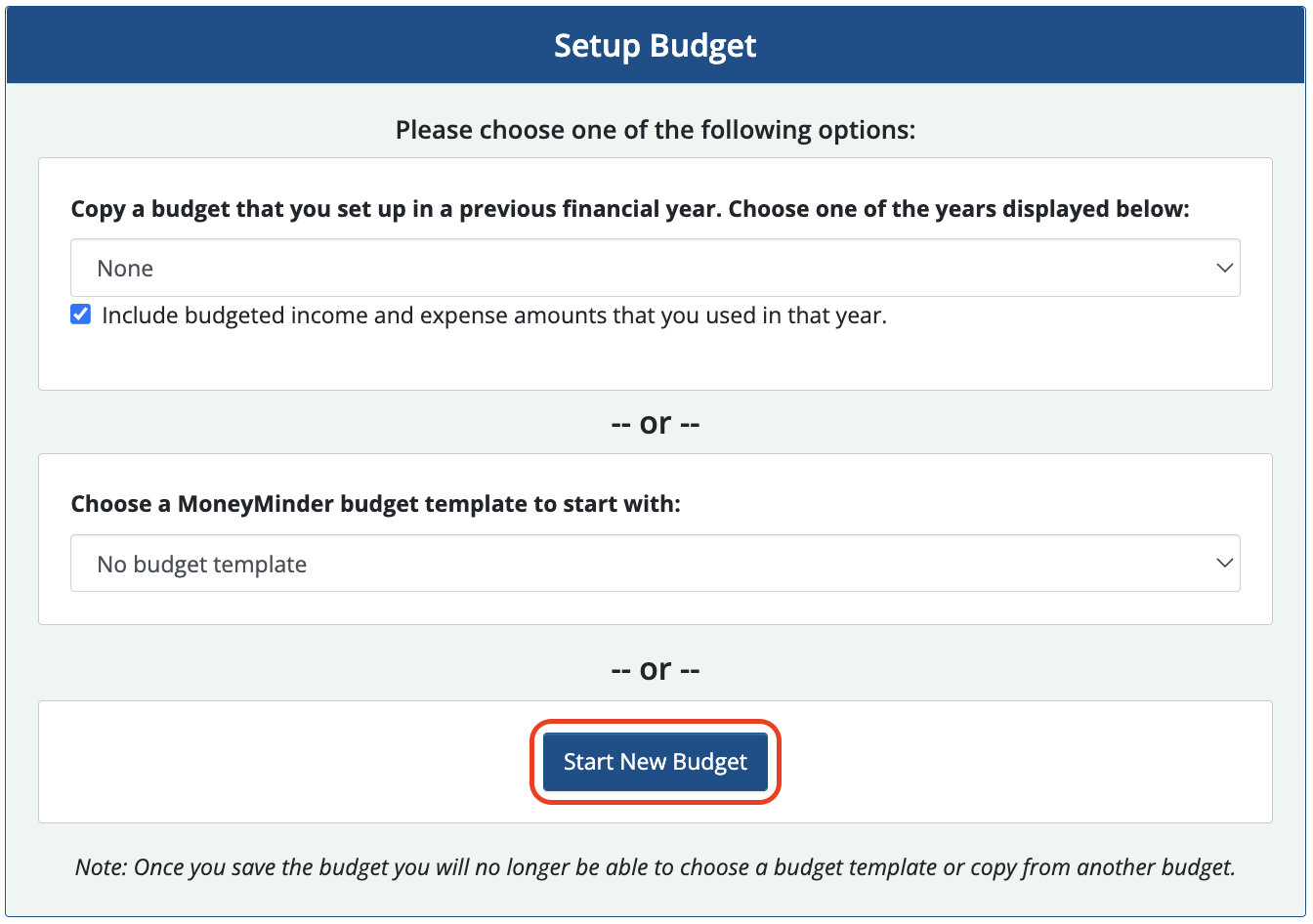
Enter the name of the first Heading.

Continue creating the budget by adding Headings, Subheadings, and Categories.
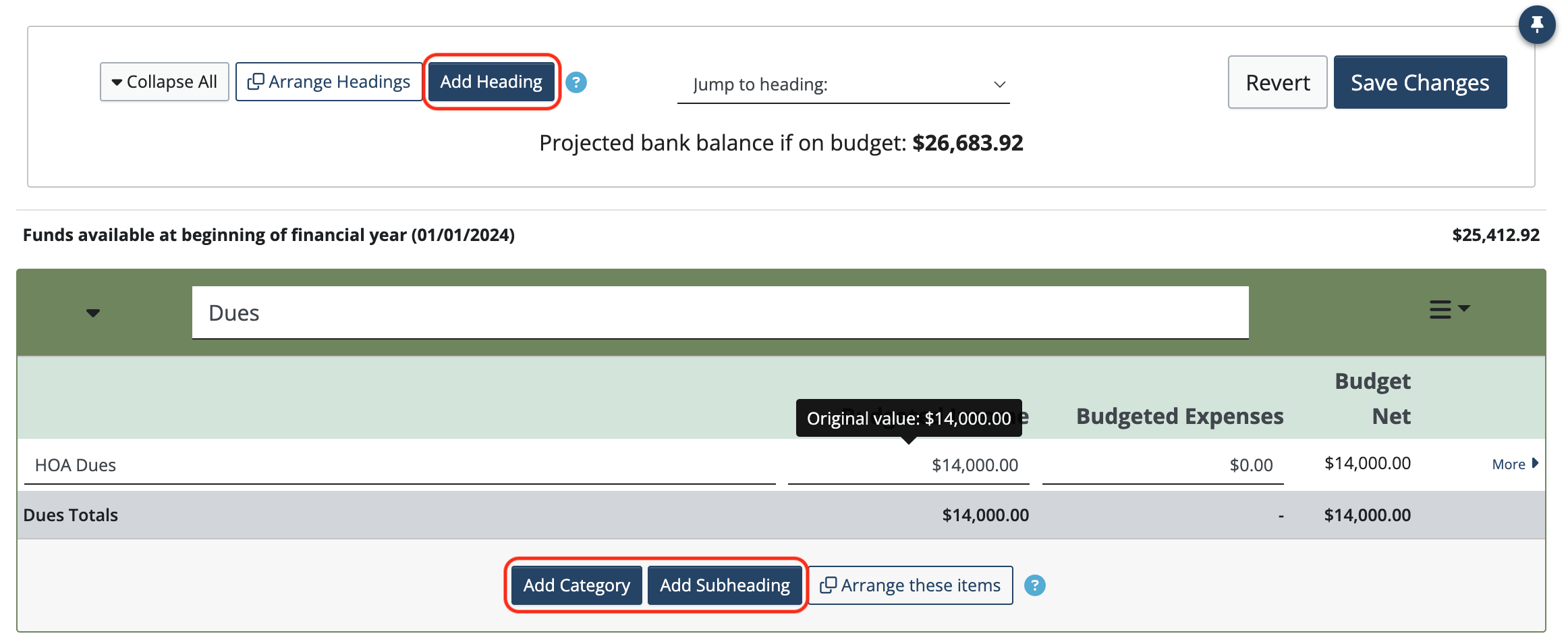
When finished, click Save Changes at the top of the budget.
To delete a Category:
- Click the More> button to the right of the category.
- Click the red Delete button. Note: You can only delete a Category if there are no transactions applied to it.
- Click Save Changes at the top of the budget.

To delete a Heading:
- Click the three lines (“hamburger”) to the right of the Heading name to open the dropdown.
- Click Delete. Note: You can only delete a Heading if there are no Categories or Subheadings listed beneath it.
- Click Save Changes at the top of the budget.

To move a Heading:
Click Arrange Headings in the static toolbar at the top of the screen.

To move a category:
Click the Arrange these items button at the bottom of the Heading or click the “hamburger” to open the dropdown and choose Arrange these items.

4. Enter a few transactions & attach receipts
To enter a DEPOSIT
Click Banking in the sidebar.
![]()
Click the Actions dropdown menu to the right of the bank account

Choose New Deposit from the dropdown.
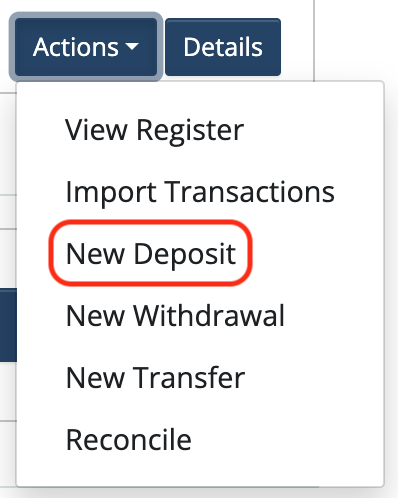
Fill in the required fields:
- Date: Enter the date the deposit was made.
- Reference: Enter the identifying reference number or words, or choose from the dropdown.
- Memo (optional): Use up to 512 characters to create a reminder about this deposit. The memo will show in the register.
- Category: Select a category from the dropdown list or add a new one. These are the budget items that were entered in the Budget screen.
- Apply to Contact (optional): This can be used if contacts pay for things like dues, team fees, or donate to the organization and you want to keep track of contact balances.
- Details (optional): Use up to 255 characters to create details about this deposit.
- Amount: Enter the amount for this portion of the deposit.
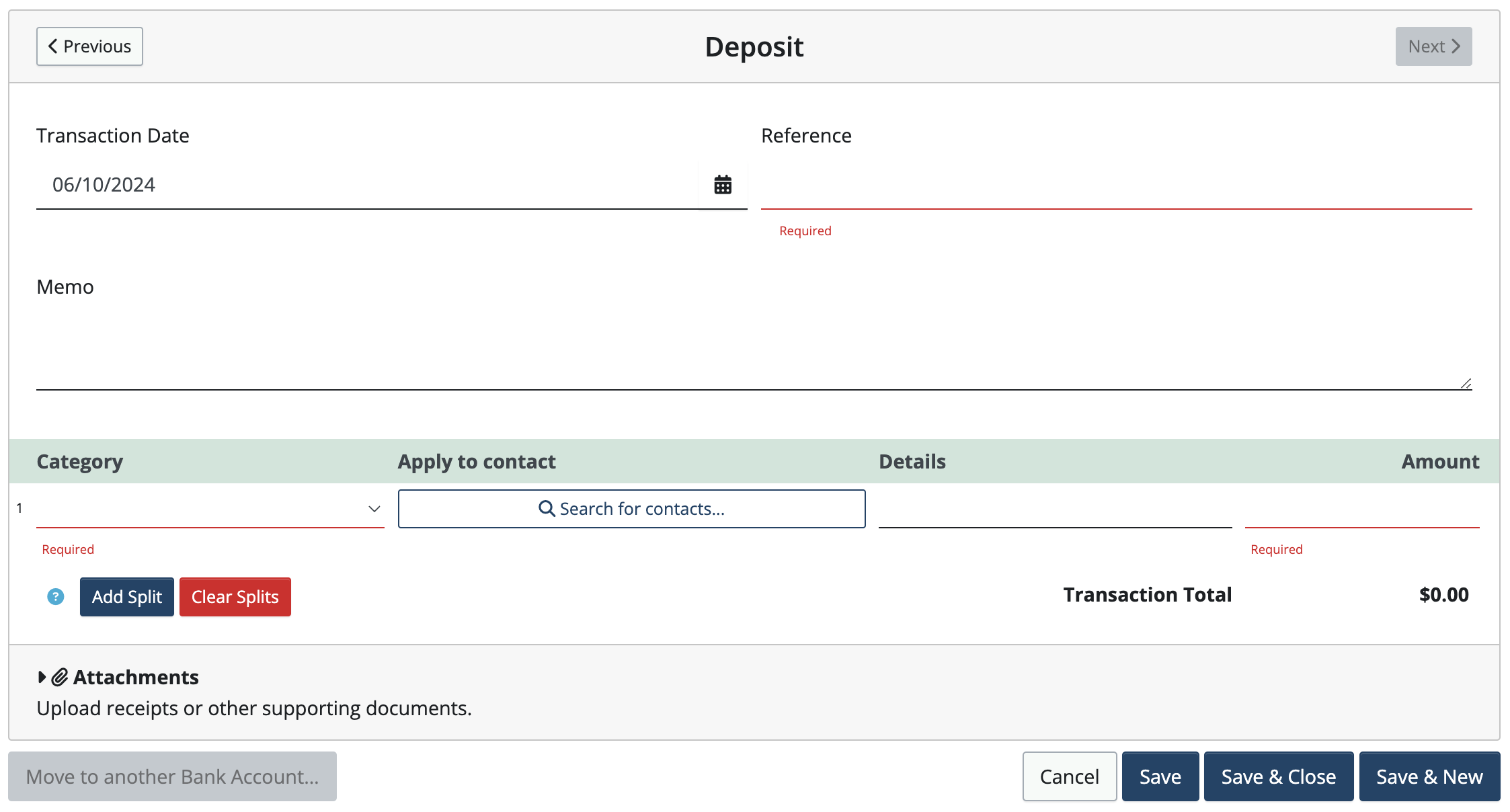
Click Add Split to add more lines to allocate various parts of a deposit to different categories or different contacts. These split amounts must equal the Transaction Total.


Click Clear Splits to delete information entered in all split lines for this transaction.
Click the garbage can to the right of a split if you want to delete only one split.
To attach a receipt to a deposit click on Attachments.
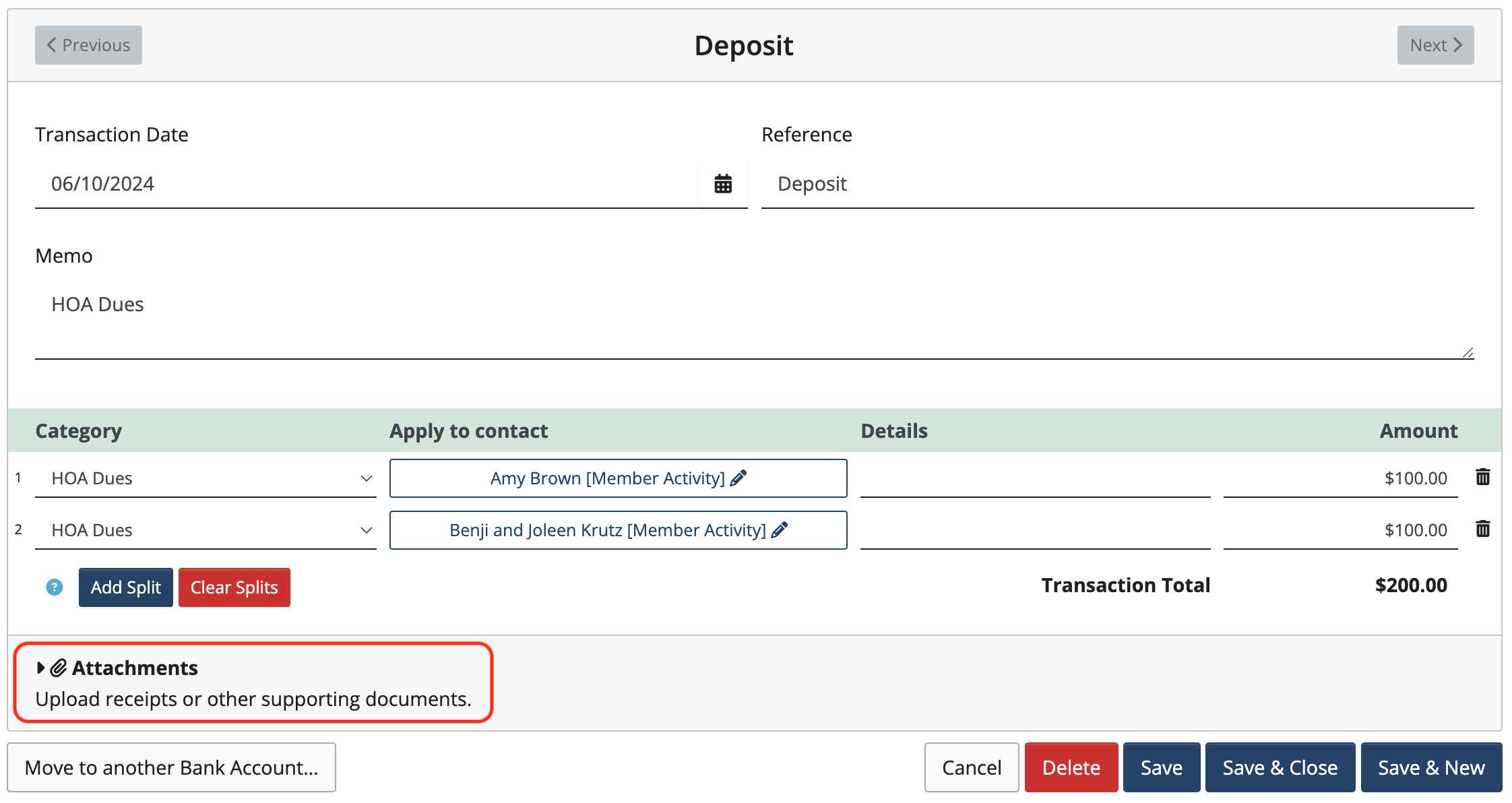
Drag & drop a file inside the dotted line OR click the words to choose a file.

Confirm that it’s been successfully uploaded.

When finished click one of the following:
- Cancel to cancel the deposit in progress and return to the bank register.
- Save to save an in-progress transaction.
- Save & Close saves the transaction and closes the window taking you back to the bank register.
- Save & New saves the transaction and opens a new window to enter another deposit.
To enter a WITHDRAWAL
Click Banking in the sidebar.
![]()
Click the Actions dropdown menu to the right of the bank account.

Choose New Withdrawal from the dropdown.
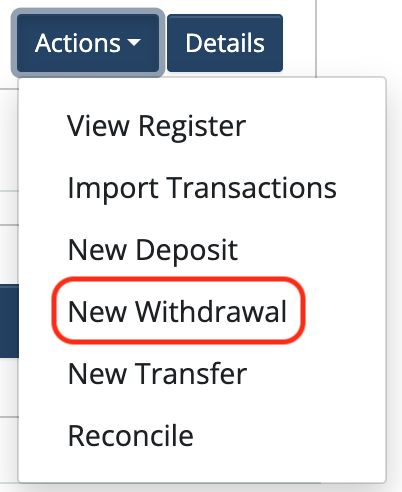
Fill in the required fields:
- Date: Date of withdrawal.
- Check #/Reference: Enter a check number or identifying words, or choose from the dropdown.
- Paid to: Select a name from the dropdown or enter the name of the person/organization the withdrawal is payable to.
- Memo (optional): Use up to 512 characters to enter notes and extra details about this withdrawal. The memo will show in the register.
- Category: Select a category from the dropdown list or add a new one. These are the budget items that were entered in the Budget screen.
- Apply to Contact (optional): This can be used if the organization reimburses a contact or pays a vendor or contractor and wants to apply the payment to the contact’s record in MoneyMinder to track it.
- Details (optional): Use up to 255 characters to create details about this withdrawal.
- Amount: Enter the amount for this portion of the withdrawal.

Click Add Split to add more lines to allocate various parts of an expense to different categories or different contacts. These split amounts must equal the Transaction Total.
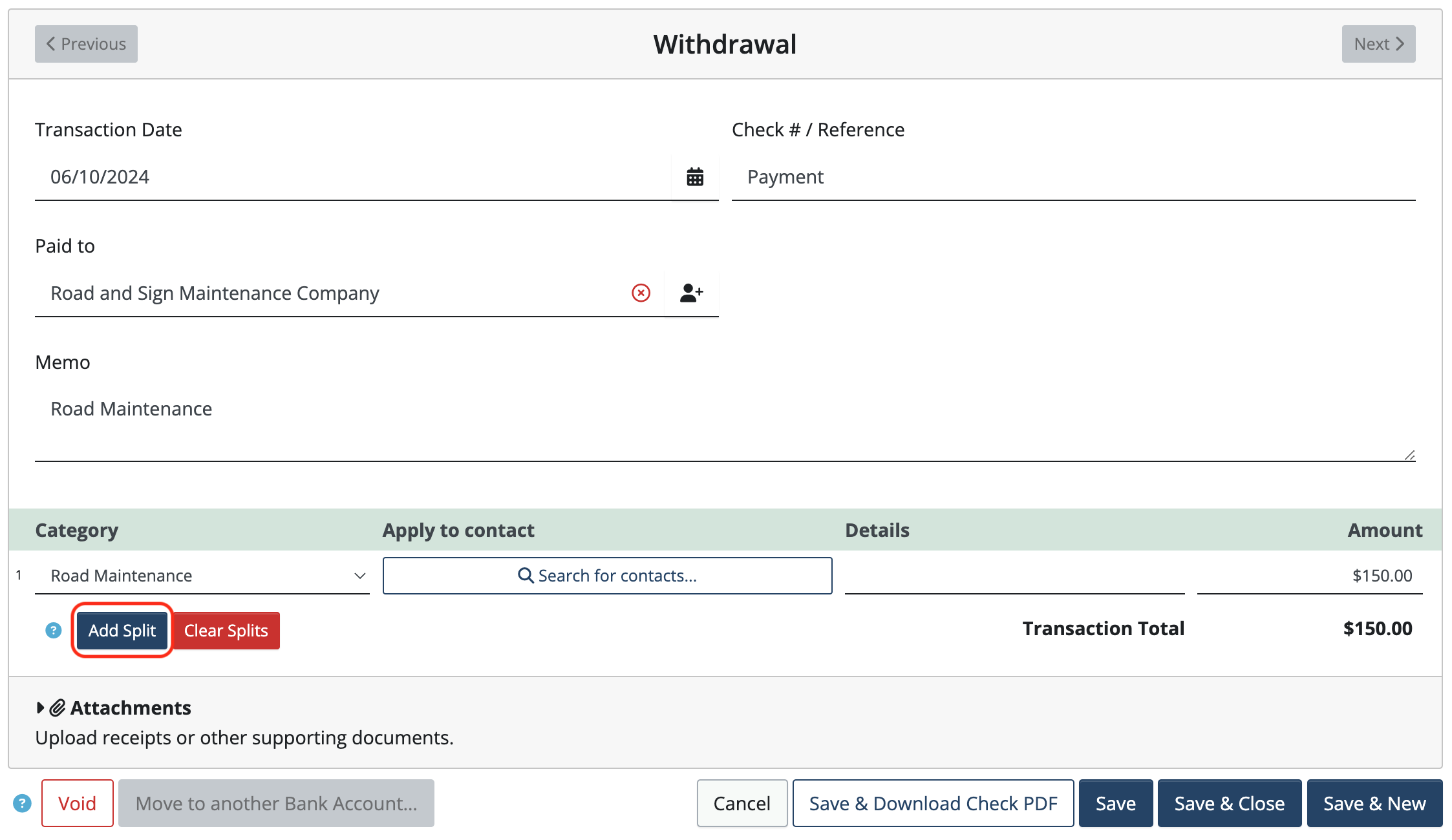
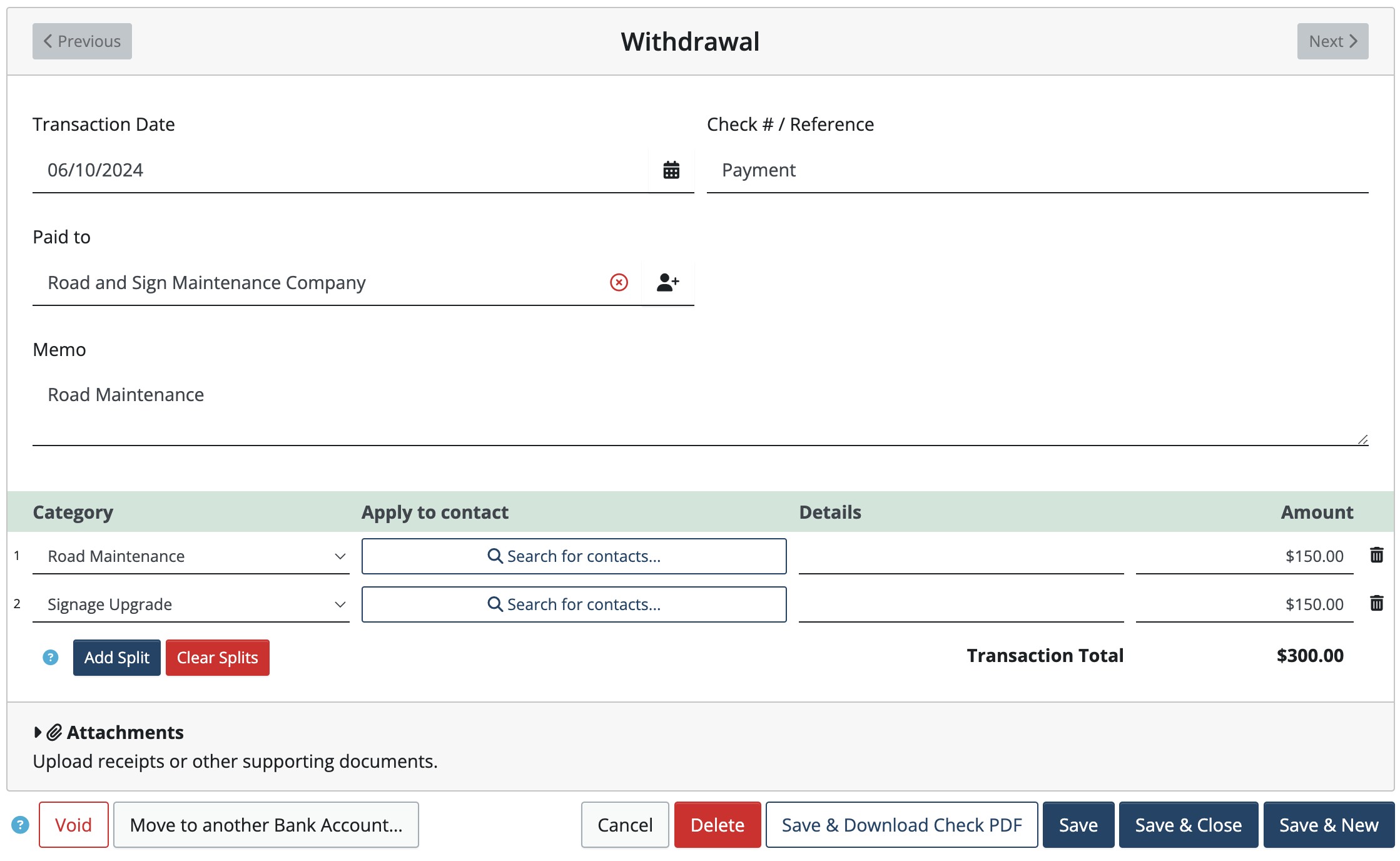
Click Clear Splits to delete information entered in all split lines for this transaction.
Click the garbage can to the right of a split if you want to delete only one split.
Click Void to save a check that is not disbursed, maintaining your check sequencing. This also keeps record of the check since it will not clear your bank.
To attach a receipt to a withdrawal click Attachments.
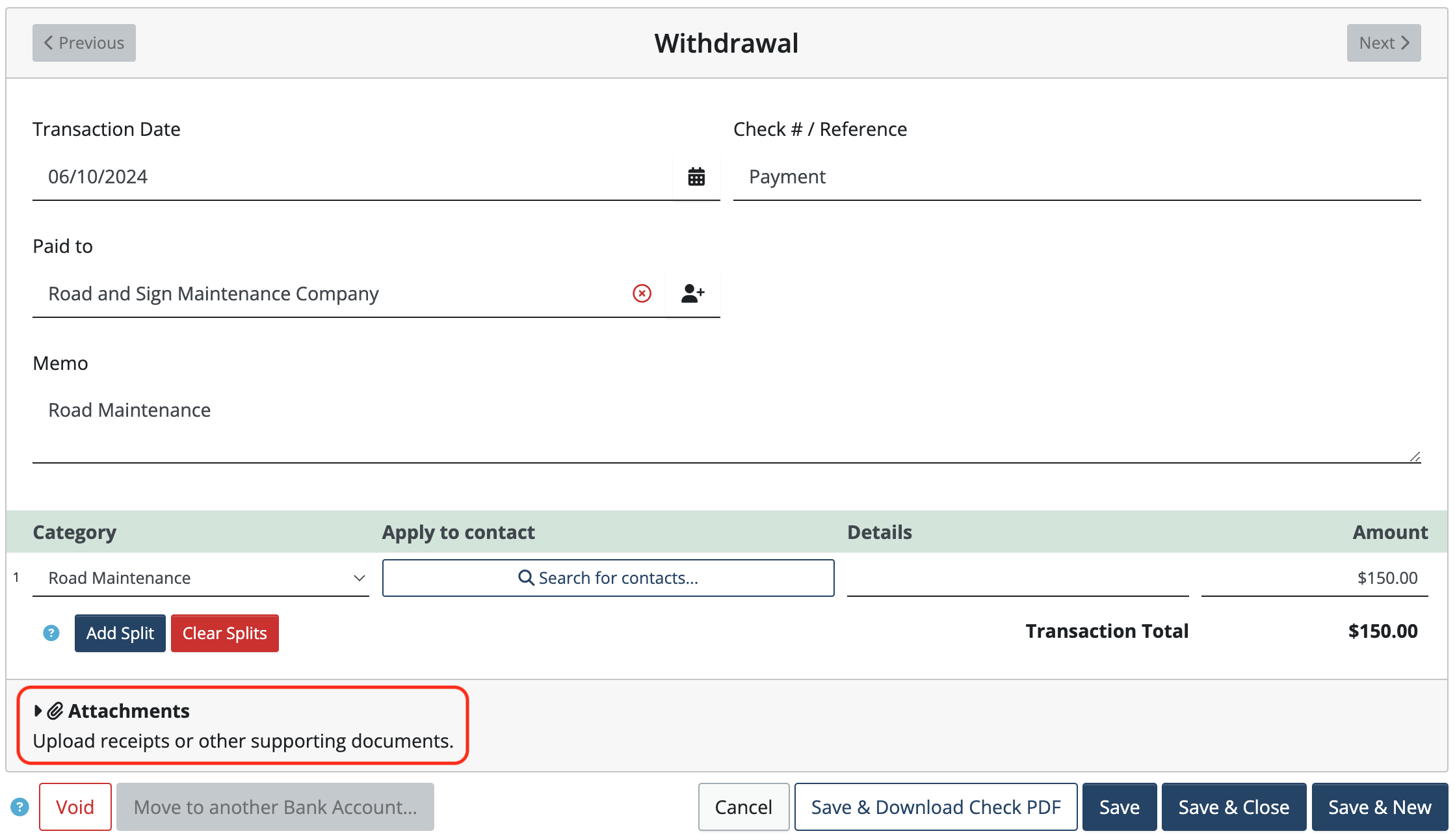
Drag & drop a file inside the dotted line OR click the words to choose a file.

Confirm that it’s been successfully uploaded.

When finished click one of the following:
- Cancel to cancel the withdrawal in progress and return to the bank register.
- Save & Download Check PDF saves the entry in MoneyMinder and simultaneously downloads a PDF to your hard drive so a check can be printed.
- Save & Close saves the transaction and closes the window taking you back to the bank register.
- Save & New saves the transaction and opens a new window to enter another withdrawal.
5. View Some Reports
MoneyMinder includes several dozen click-of-the-mouse reports.
Click Reports in the sidebar.
![]()
Click the report you’d like to view.
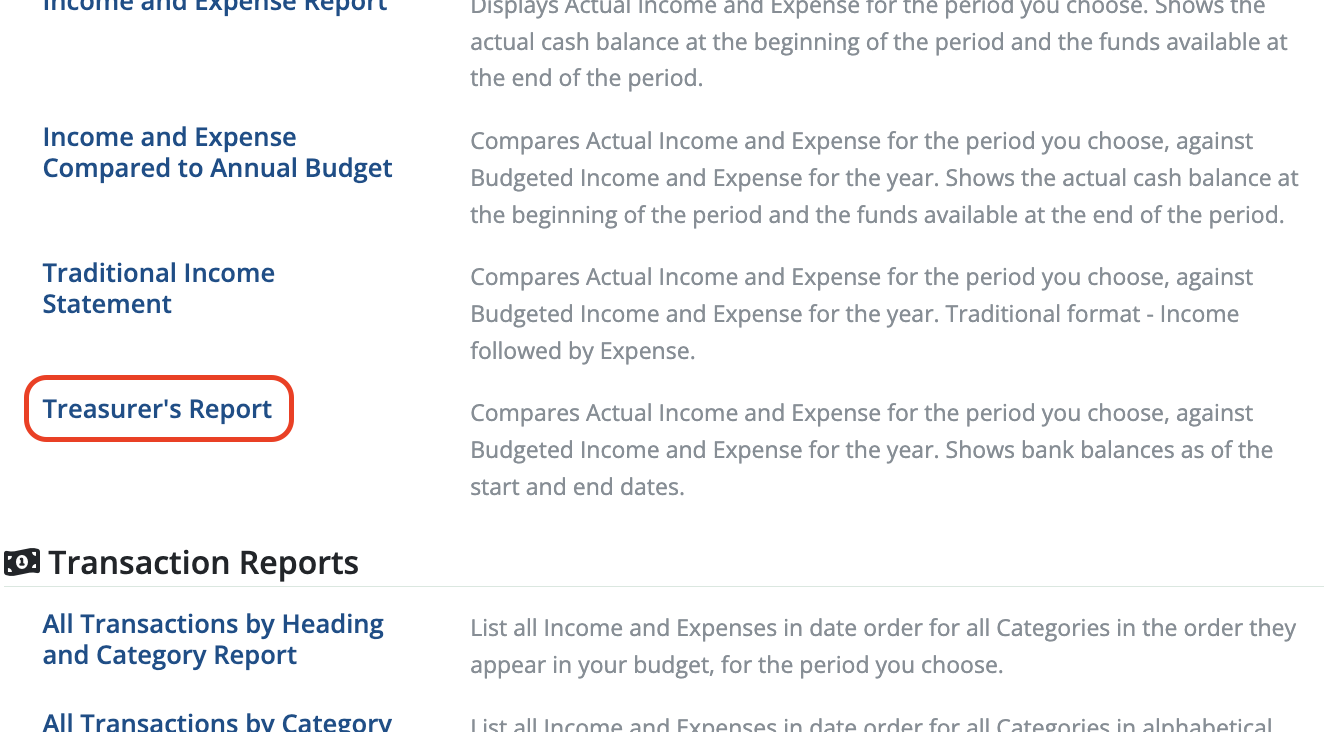
Most reports have the option to Print, Export to PDF, or Export to Excel.

Here are some of the most popular reports:
The Treasurer’s Report
Many Treasurers take this report to their monthly meeting as it provides total income & expenses against budget for the time period you choose. It also shows bank balances as of the start & end dates.
The Budget Report
Displays the Budget for the year. Shows the actual balance carried forward from last year and the projected budgeted carry forward to next year.
Reconciliations Report
Displays detailed information for each bank reconciliation for the Bank Account you choose.
All Transactions by Category Report
List all Income and Expenses in date order for all Categories in alphabetical order, for the period you choose. You can also choose to show only selected categories.
The Audit Report
Summary report comparing Bank Statement balances to your MoneyMinder balances to ensure that they match.
Check out these reports and others to see what’s available.
6. Add Users
MoneyMinder allows groups to add users to an account for no additional fee. The level of access is determined by the User Role selected.
Click Settings in the sidebar.
![]()
To add a new user:
Scroll down to the Users section of the page. Click Add New User.

- Enter name and email address
- Select a Role: (Treasurers should be assigned the Administrator Role)
- Click Send Invite
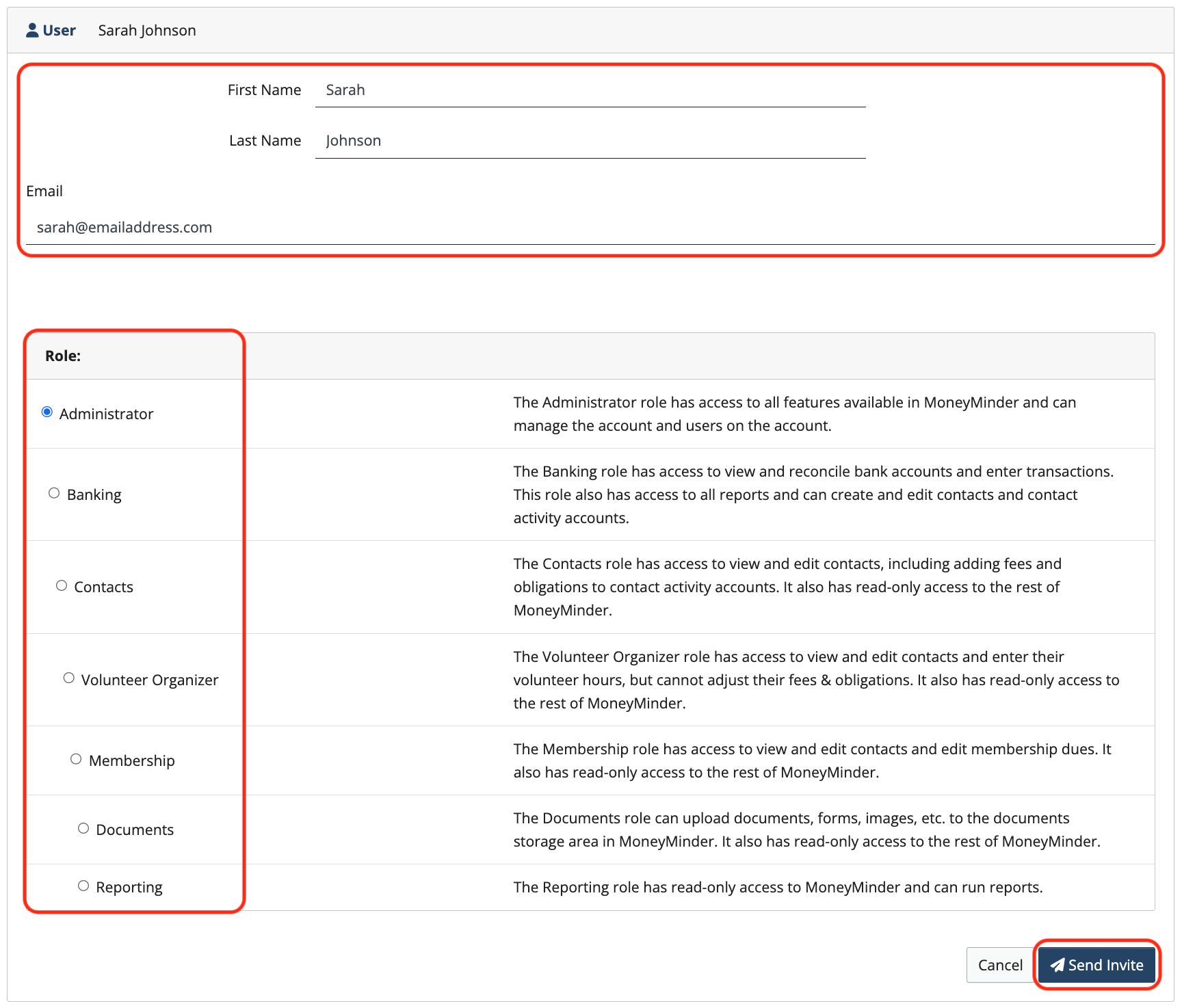
This will send an invitation to the email address that was entered with a link to create a password. After the password has been created, the new user will be prompted to log in.
To edit user:
Click the Edit button associated with their name:

Name, email, password, and user role can be updated here.
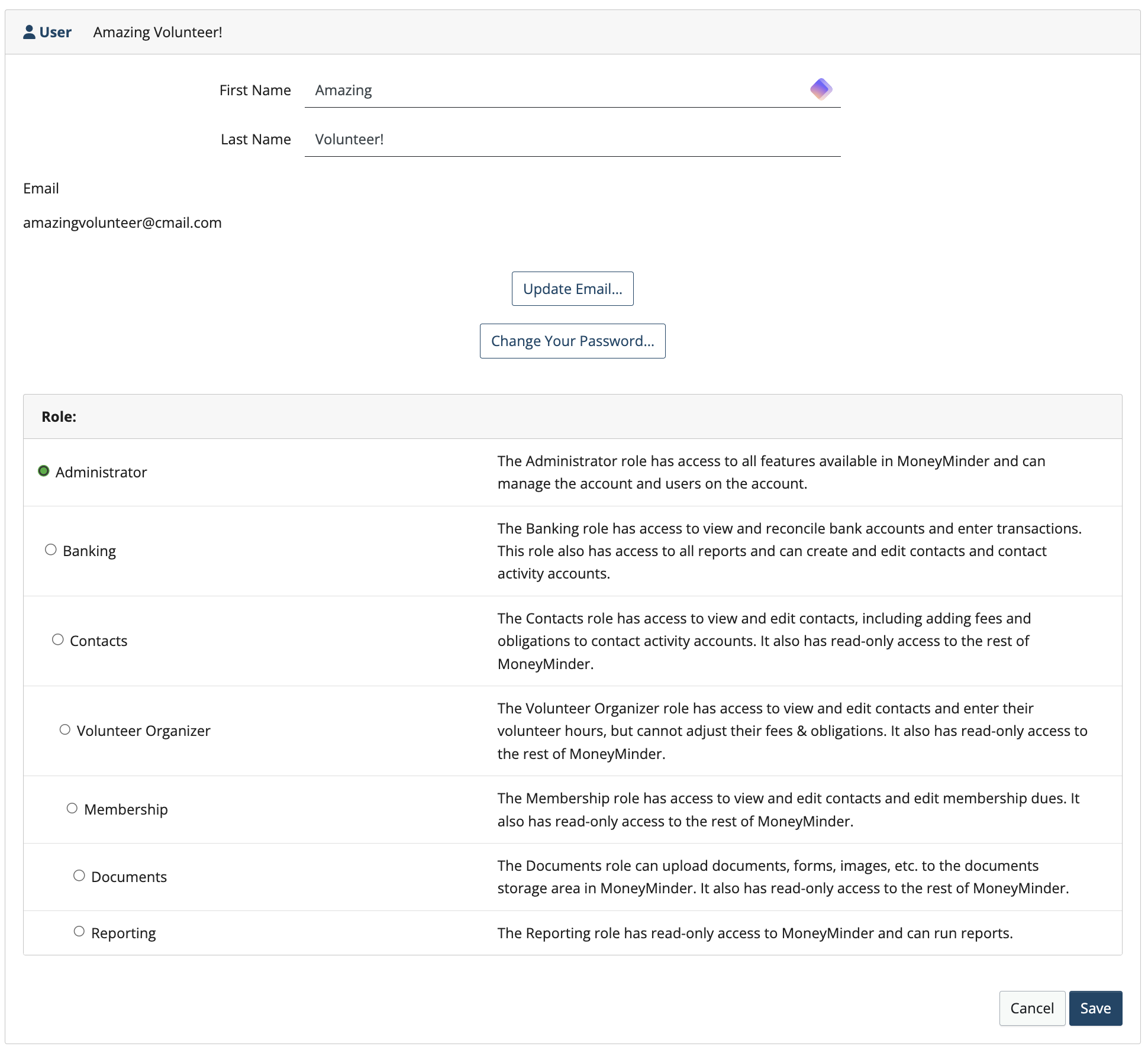
Click Save when finished.
To remove a user:
Click the Edit button associated with user.

Scroll to the bottom of the page and click Remove User from Group.
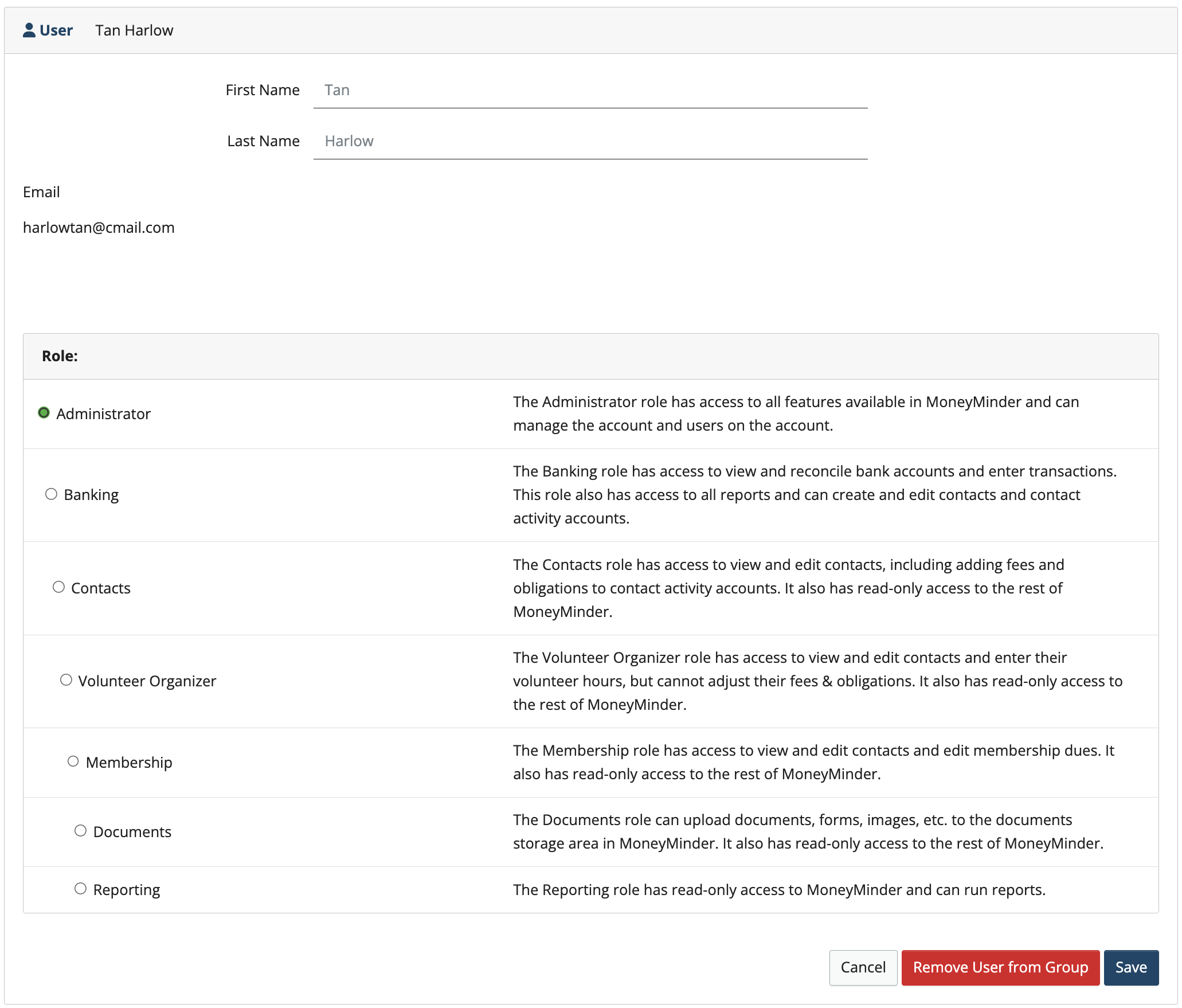
7. Set Up Your Own Custom Store
Click Store in the sidebar:
![]()
Review the features and fees and click Set Up Your Store.
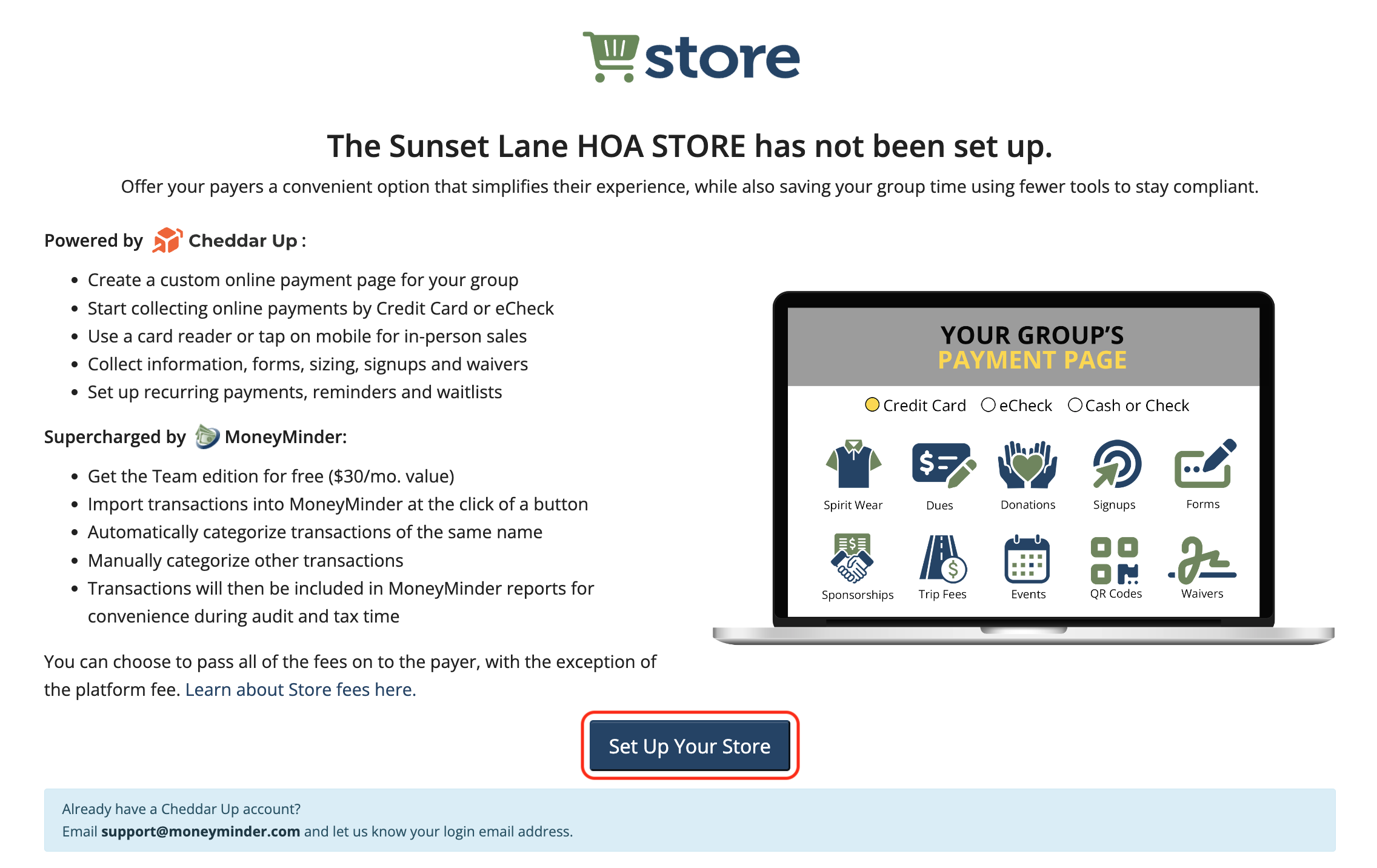
Enter first and last name, and an email address. Then click Register.
We recommend using the group’s email address when setting up the store so future treasurers can use the same login.

Already have a CheddarUp store? Email us to get it connected to your MoneyMinder Account: [email protected]
Click View and Manage Your Store to begin setting up access Cheddar Up.

To get started and learn how to create collections and manage payments, check out Cheddar Up’s fantastic knowledgebase.
8. Upload Documents
The Documents feature allows forms and records to be uploaded & stored.
Some common items that groups upload are Meeting Minutes, Bylaws, 990(EZ) forms, Meeting Agendas, Check Request Forms, Audit Findings, NSF Check Letters, Flyers, other IRS documentation, etc.
The maximum file size allowed for upload is 20MB per file.
Click on the Documents icon in the toolbar.
![]()
Click Upload Files.
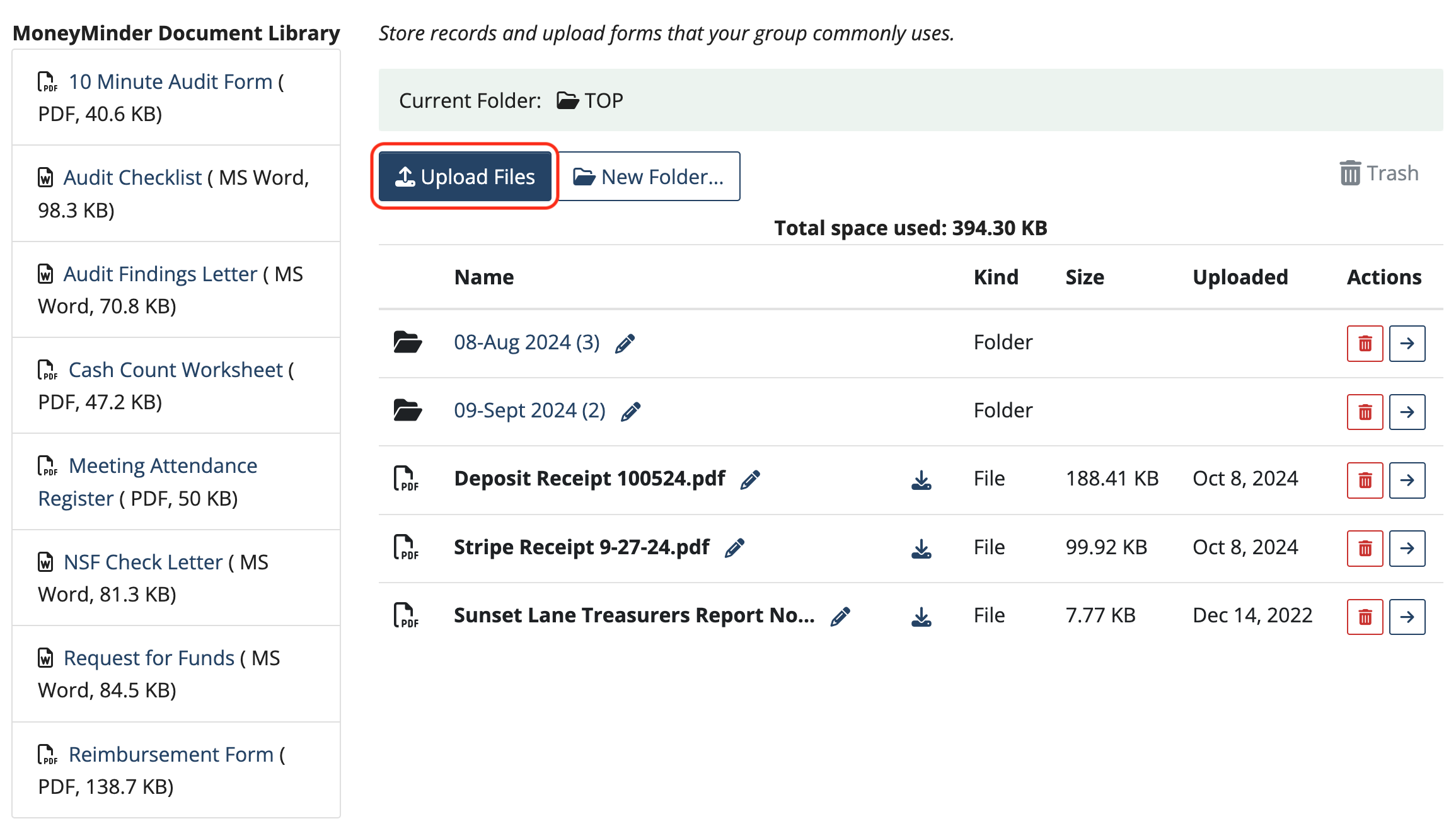
Next either drag & drop a file or choose a file from your file browser window.
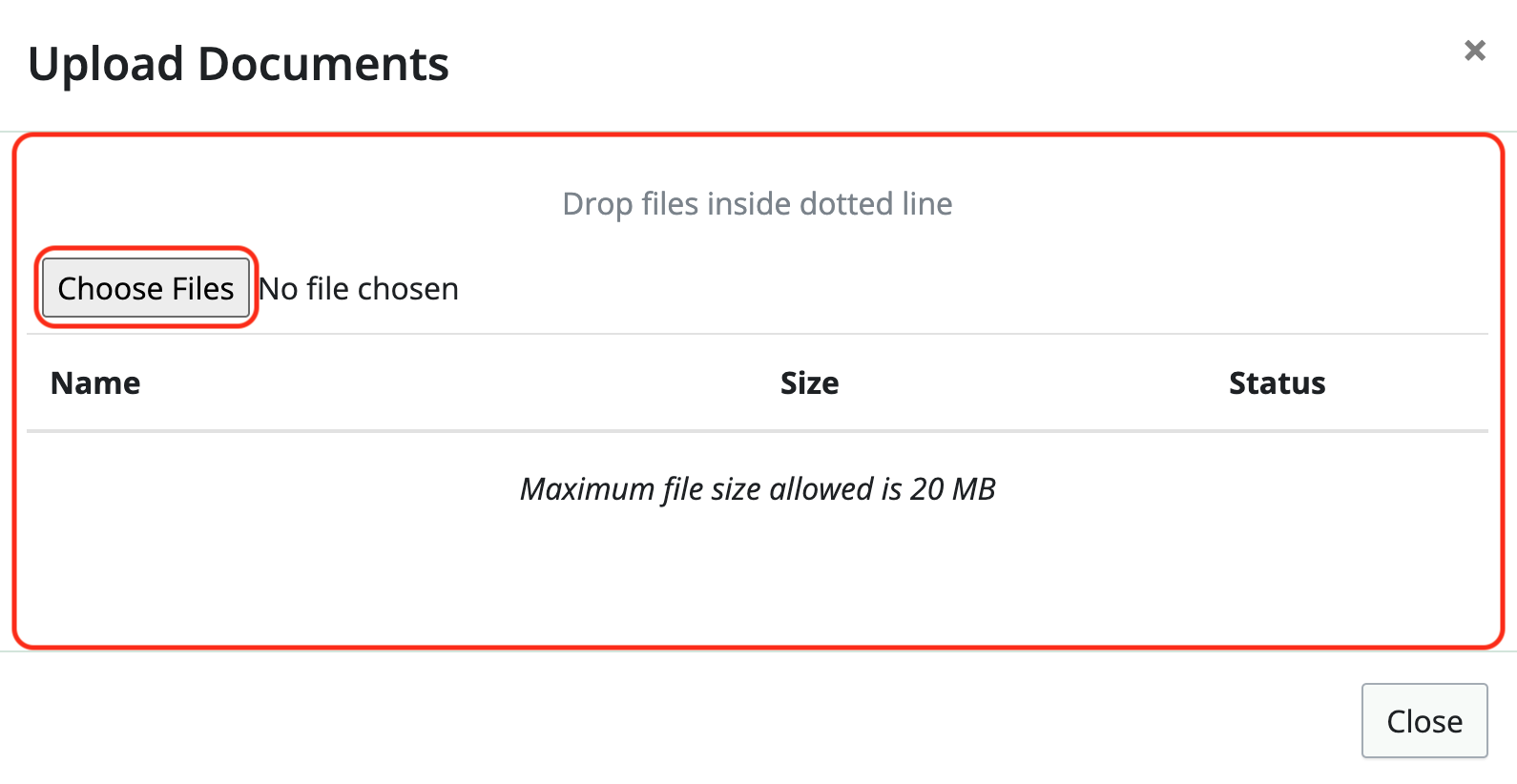
Once the file has been uploaded, the Status will show Successfully Uploaded.
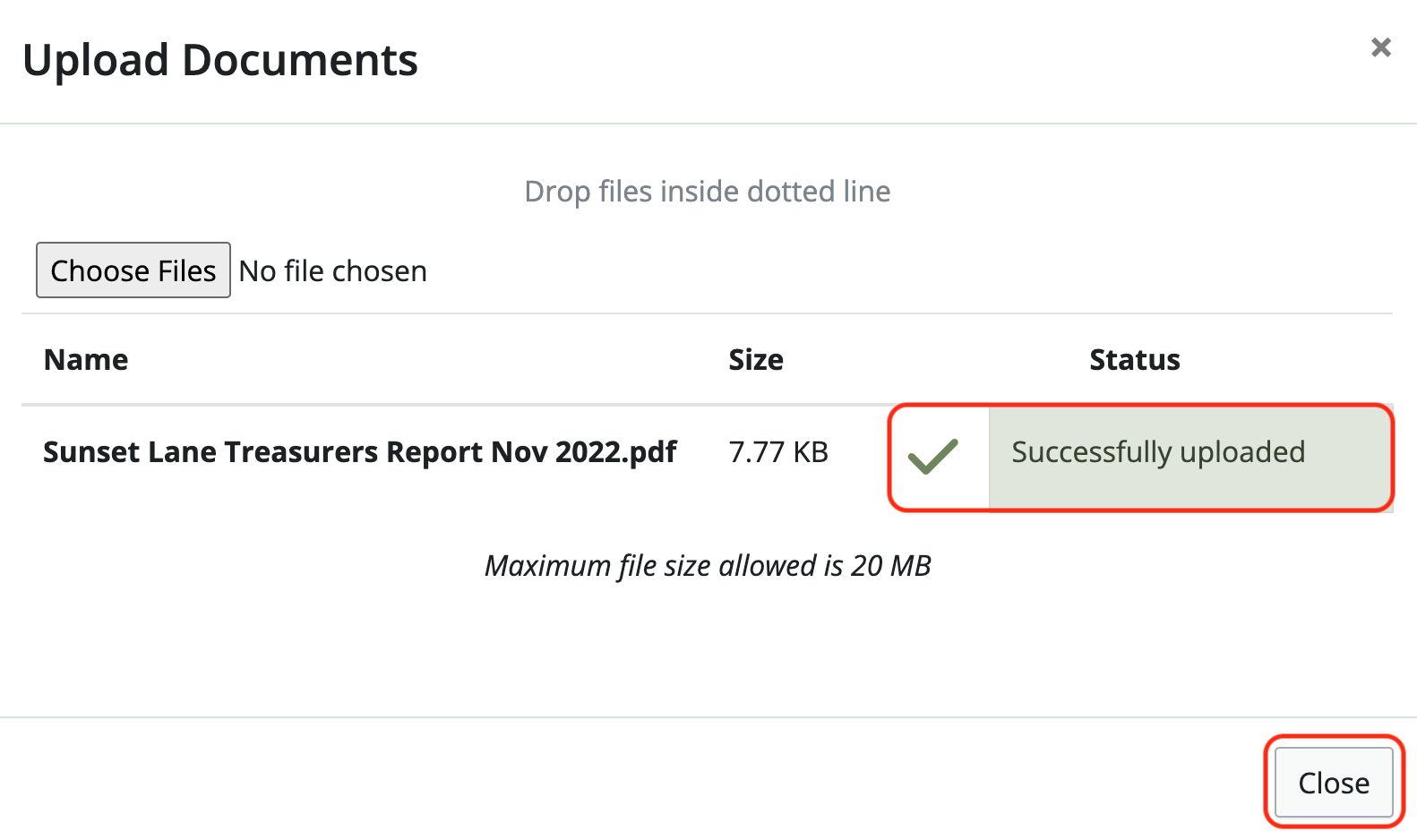
Click Close when you’re done uploading.
That file will then be listed in the directory.

Organizing your documents
Click TOP to go to the main folder list.
Click on any Folder name to open the folder.
Click on an item name to open a viewer window to view the document if it’s a PDF or image file.
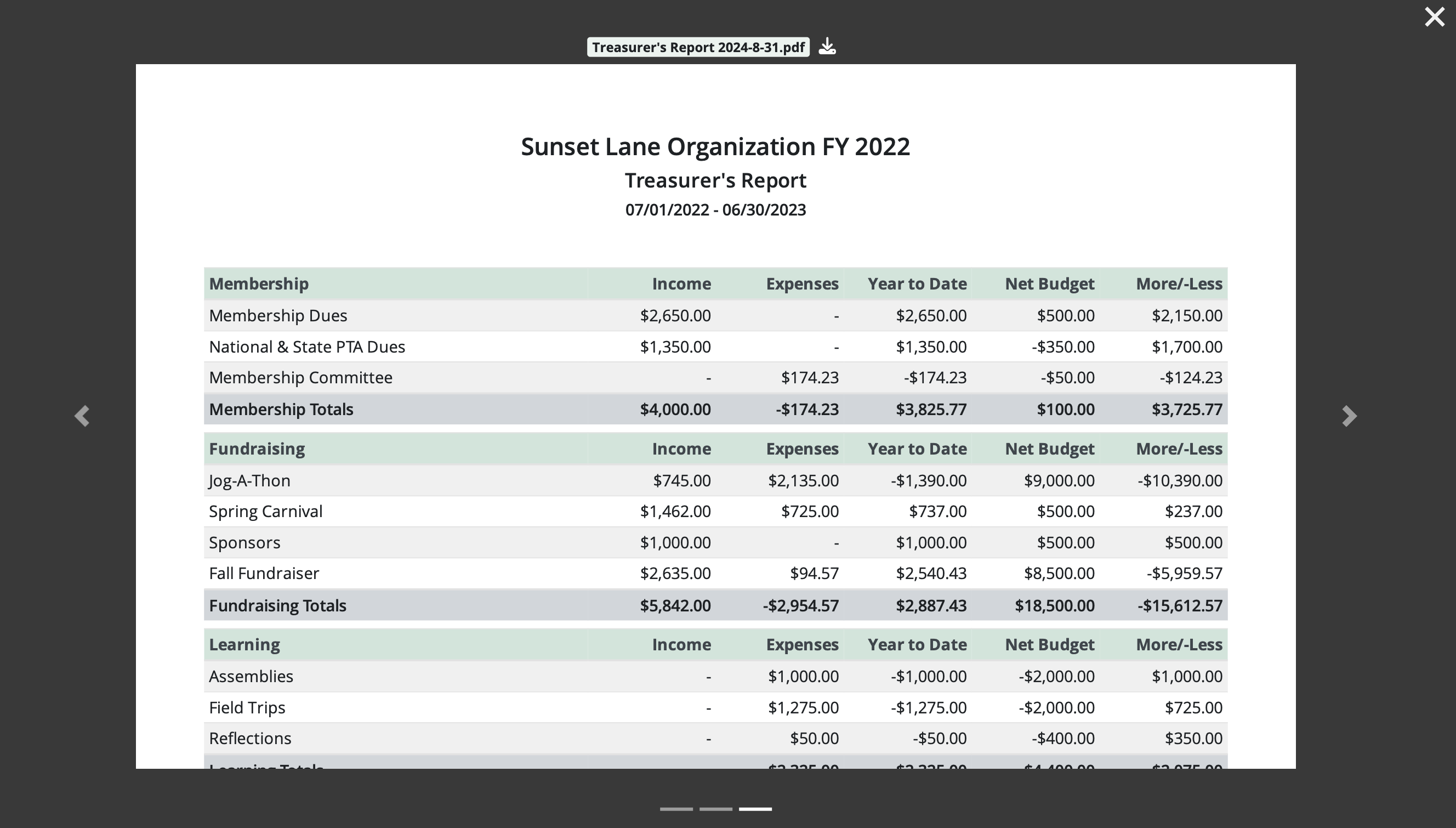
If it’s not an image or PDF, you’ll see the message, [File name] cannot be previewed, please download instead. Click the word download to initiate the process.

Click on the blue arrow icon to the right of an item or folder to move it into another folder.

Removing documents
To delete a document, click the trash can icon to the right of the document name.

Permanently deleting documents
When a document is deleted, it is moved to the Trash can.
To permanently delete an item, click Trash to see a list of items in the Trash can.

Click the red “x” to the right of an item to permanently delete it. Click Empty trash… to permanently delete all items in the Trash.

 Connect your Venmo account to MoneyMinder PRO to directly download transactions, saving you time and effort. You just review the transactions to ensure they are properly categorized and fill out any required fields.
Connect your Venmo account to MoneyMinder PRO to directly download transactions, saving you time and effort. You just review the transactions to ensure they are properly categorized and fill out any required fields. Connect your Bank, Square and PayPal accounts to MoneyMinder PRO to directly download transactions, saving you time and effort. You just review the transactions to ensure they are properly categorized and fill out any required fields.
Connect your Bank, Square and PayPal accounts to MoneyMinder PRO to directly download transactions, saving you time and effort. You just review the transactions to ensure they are properly categorized and fill out any required fields. Connect your Bank, Paypal and Square accounts to MoneyMinder PRO to directly download transactions, saving you time and effort. You just review the transactions to ensure they are properly categorized and fill out any required fields.
Connect your Bank, Paypal and Square accounts to MoneyMinder PRO to directly download transactions, saving you time and effort. You just review the transactions to ensure they are properly categorized and fill out any required fields. Connect your Bank, Paypal and Square accounts to MoneyMinder PRO to directly download transactions, saving you time and effort. You just review the transactions to ensure they are properly categorized and fill out any required fields.
Connect your Bank, Paypal and Square accounts to MoneyMinder PRO to directly download transactions, saving you time and effort. You just review the transactions to ensure they are properly categorized and fill out any required fields. Join It is a membership management service that helps businesses and nonprofits effectively sell, track, and grow their membership.
Join It is a membership management service that helps businesses and nonprofits effectively sell, track, and grow their membership.